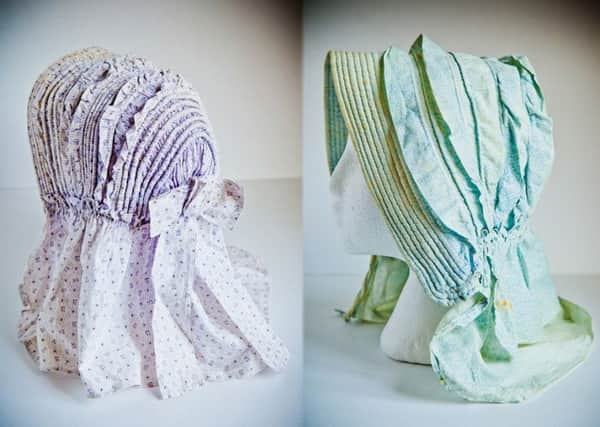Exhibit of the Week: Sunbonnets - Woodhams Stone Collection, Malton


The dress of the working classes are under represented. This is not intentional.
Working clothes wear out and so do not survive in the same numbers as those garments that were cherished for their associations or kept for best. There are some exceptions to this such as the rural labourer’s smock and the countrywoman’s sunbonnet. The design and craftsmanship that often went into creating these garments has meant that they are treasured and preserved by later generations.
Advertisement
Hide AdAdvertisement
Hide AdThe Woodhams Stone Collection is fortunate to have two sunbonnets. Both date from the late 1900s and are made from machine printed cottons of that time.
Such bonnets were common from about 1840 right up to the First World War, changing very little over this period.
They developed from the small round cotton caps of the 18th century worn by women indoors and out. Extra shading was provided for outdoor wear with the addition of a straw hat or even a hood with a caned rim which shielded the face from the sun.
The design of the sunbonnet was wholly practical. It was usually home-made from cotton or calico (an unbleached and not fully finished cotton fabric) and the brim and crown were corded.
Advertisement
Hide AdAdvertisement
Hide AdThis involved stitching lengths of cord into parallel channels, giving the bonnet structure and shape.
A frill or ‘curtain’ was attached at the back, covering the neck and shoulders and the bonnet tied beneath the chin with long ties. It gave the countrywoman protection from the elements whilst working outside.
It shielded her from the sun, the wind and to some extent the rain.
Protecting yourself from the effects of the sun was no less important to past generations than it is today, even without a knowledge of the dangers of skin cancer.
Advertisement
Hide AdAdvertisement
Hide AdTanned, or worst burnt skin, was to be avoided at all cost; for cosmetic as much as for health reasons.
The bonnets were first and foremost workwear and their design was practical. The addition of frills, ruching and commonly a large bow on the back also made them attractive and unique items of costume.
The countrywoman’s sunbonnet was distinctive of its time and class, a practical piece of clothing that was outside fashion.
Its aesthetic qualities, however, have seen it cherished and preserved for later generations.